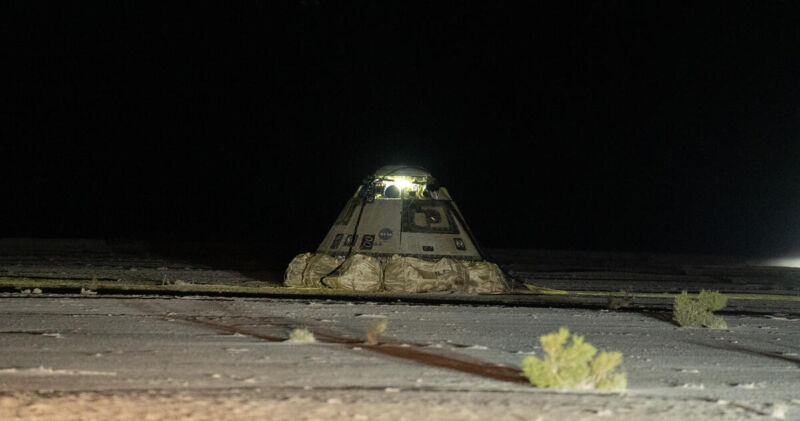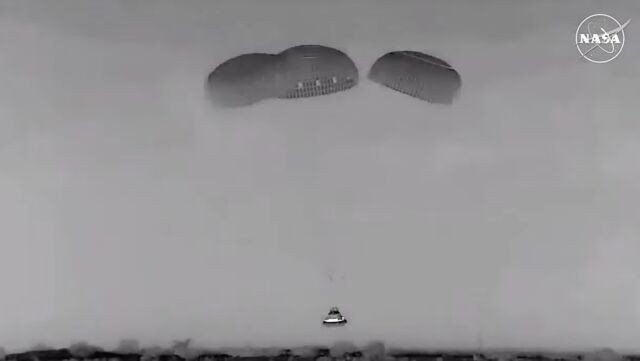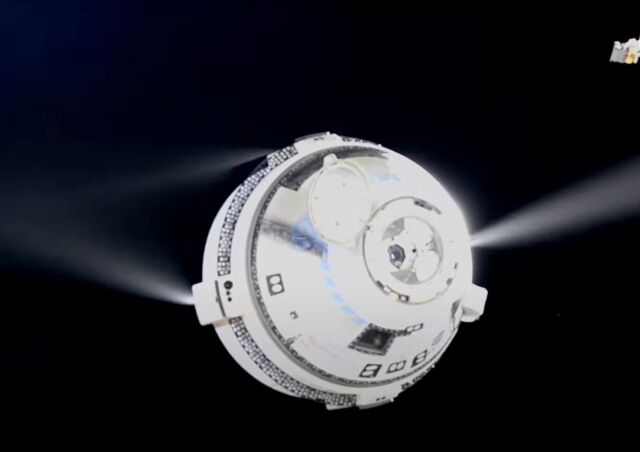It worked —
“We will review the data and determine the next steps for the program,” says Boeing’s Starliner manager.

Enlarge / Boeing’s Starliner spacecraft after landing Friday night at White Sands Space Harbor, New Mexico.
Boeing
Boeing’s Starliner spacecraft sailed to a smooth landing in the New Mexico desert Friday night, an auspicious end to an otherwise disappointing three-month test flight that left the capsule’s two-person crew stuck in orbit until next year.
Cushioned by airbags, the Boeing crew capsule descended under three parachutes toward an on-target landing at 10: 01 pm local time Friday (12: 01 am EDT Saturday) at White Sands Space Harbor, New Mexico. From the outside, the landing appeared just as it would have if the spacecraft brought home NASA astronauts Butch Wilmore and Suni Williams, who became the first people to launch on a Starliner capsule on June 5.
But Starliner’s cockpit was empty as it flew back to Earth Friday night. Last month, NASA managers decided to keep Wilmore and Williams on the International Space Station (ISS) until next year after agency officials determined it was too risky for the astronauts to return to the ground on Boeing’s spaceship. Instead of coming home on Starliner, Wilmore and Williams will fly back to Earth on a SpaceX Dragon spacecraft in February. NASA has incorporated the Starliner duo into the space station’s long-term crew.
The Starliner spacecraft began the journey home by backing away from its docking port at the space station at 6: 04 pm EDT (22: 04 UTC), one day after astronauts closed hatches to prepare for the ship’s departure. The capsule fired thrusters to quickly back away from the complex, setting up for a deorbit burn to guide Starliner on a trajectory toward its landing site. Then, Starliner jettisoned its disposable service module to burn up over the Pacific Ocean, while the crew module, with a vacant cockpit, took aim on New Mexico.
After streaking through the atmosphere over the Pacific Ocean and Mexico, Starliner deployed three main parachutes to slow its descent, then a ring of six airbags inflated around the bottom of the spacecraft to dampen the jolt of touchdown. This was the third time a Starliner capsule has flown in space, and the second time the spacecraft fell short of achieving all of its objectives.
Not the desired outcome
“I’m happy to report Starliner did really well today in the undock, deorbit, and landing sequence,” said Steve Stich, manager of NASA’s commercial crew program, which manages a contract worth up to $4.6 billion for Boeing to develop, test, and fly a series of Starliner crew missions to the ISS.
While officials were pleased with Starliner’s landing, the celebration was tinged with disappointment.
“From a human perspective, all of us feel happy about the successful landing, but then there’s a piece of us that we wish it would have been the way we had planned it,” Stich said. “We had planned to have the mission land with Butch and Suni onboard. I think there are, depending on who you are on the team, different emotions associated with that, and I think it’s going to take a little time to work through that.”
Nevertheless, Stich said NASA made the right call last month when officials decided to complete the Starliner test flight without astronauts in the spacecraft.
“We made the decision to have an uncrewed flight based on what we knew at the time, and based on our knowledge of the thrusters and based on the modeling that we had,” Stich said. “If we’d had a model that would have predicted what we saw tonight perfectly, yeah, it looks like an easy decision to go say, ‘We could have had a crew tonight.’ But we didn’t have that.”
Boeing’s Starliner managers insisted the ship was safe to bring the astronauts home. It might be tempting to conclude the successful landing Friday night vindicated Boeing’s views on the thruster problems. However, he spacecraft’s propulsion system, provided by Aerojet Rocketdyne, clearly did not work as intended during the flight. NASA had the option of bringing Wilmore and Williams back to Earth on a different, flight-proven spacecraft, so they took it.
“It’s awfully hard for the team,” Stich said. “It’s hard for me, when we sit here and have a successful landing, to be in that position. But it was a test flight, and we didn’t have confidence, with certainty, of the thruster performance.”

Enlarge / In this infrared view, Starliner descends under its three main parachutes moments before touchdown at White Sands Space Harbor, New Mexico.
NASA
As Starliner approached the space station in June, five of 28 control thrusters on Starliner’s service module failed, forcing Wilmore to take manual control as ground teams sorted out the problem. Eventually, engineers recovered four of the five thrusters, but NASA’s decision makers were unable to convince themselves the same problem wouldn’t reappear, or get worse, when the spacecraft departed the space station and headed for reentry and landing.
Engineers later determined the control jets lost thrust due to overheating, which can cause Teflon seals in valves to swell and deform, starving the thrusters of propellant. Telemetry data beamed back to the mission controllers from Starliner showed higher-than-expected temperatures on two of the service module thrusters during the flight back to Earth Friday night, but they continued working.
Ground teams also detected five small helium leaks on Starliner’s propulsion system soon after its launch in June. NASA and Boeing officials were aware of one of the leaks before the launch, but decided to go ahead with the test flight. Starliner was still leaking helium when the spacecraft undocked from the station Friday, but the leak rate remained within safety tolerances, according to Stich.
A couple of fresh technical problems cropped up as Starliner cruised back to Earth. One of 12 control jets on the crew module failed to ignite at any time during Starliner’s flight home. These are separate thrusters from the small engines that caused trouble earlier in the Starliner mission. There was also a brief glitch in Starliner’s navigation system during reentry.
Where to go from here?
Three NASA managers, including Stich, took questions from reporters in a press conference early Saturday following Starliner’s landing. Two Boeing officials were also supposed to be on the panel, but they canceled at the last minute. Boeing didn’t explain their absence, and the company has not made any officials available to answer questions since NASA chose to end the Starliner test flight without the crew aboard.
“We view the data and the uncertainty that’s there differently than Boeing does,” said Jim Free, NASA’s associate administrator, in an August 24 press conference announcing the agency’s decision on how to end the Starliner test flight. It’s unusual for NASA officials to publicly discuss how their opinions differ from those of their contractors.
Joel Montalbano, NASA’s deputy associate administrator for space operations, said Saturday that Boeing deferred to the agency to discuss the Starliner mission in the post-landing press conference.
Here’s the only quote from a Boeing official on Starliner’s return to Earth. It came in the form of a three-paragraph written statement Boeing emailed to reporters about a half-hour after Starliner’s landing: “I want to recognize the work the Starliner teams did to ensure a successful and safe undocking, deorbit, re-entry and landing,” said Mark Nappi, vice president and program manager of Boeing’s commercial crew program. “We will review the data and determine the next steps for the program.”
Nappi’s statement doesn’t answer one of the most important questions reporters would have asked anyone from Boeing if they participated in Saturday morning’s press conference: Does Boeing still have a long-term commitment to the Starliner program?
So far, the only indications of Boeing’s future plans for Starliner have come from second-hand anecdotes relayed by NASA officials. Boeing has been silent on the matter. The company has reported nearly $1.6 billion in financial charges to pay for previous delays and cost overruns on the Starliner program, and Boeing will again be on the hook to pay to fix the problems Starliner encountered in space over the last three months.
Montalbano said Boeing’s Starliner managers met with ground teams at mission control in Houston following the craft’s landing. “The Boeing managers came into the control room and congratulated the team, talked to the NASA team, so Boeing is committed to continue their work with us,” he said.

Enlarge / Boeing’s Starliner spacecraft fires thrusters during departure from the International Space Station on Friday.
NASA
NASA isn’t ready to give up on Starliner. A fundamental tenet of NASA’s commercial crew program is to foster the development of two independent vehicles to ferry astronauts to and from the International Space Station, and eventually commercial outposts in low-Earth orbit. NASA awarded multibillion-dollar contracts to Boeing and SpaceX in 2014 to complete development of their Starliner and Crew Dragon spaceships.
SpaceX’s Dragon started flying astronauts in 2020. NASA would like to have another US spacecraft for crew rotation flights to support the ISS. If Boeing had more success with this Starliner test flight, NASA expected to formally certify the spacecraft for operational crew flights beginning next year. Once that happens, Starliner will enter a rotation with SpaceX’s Dragon to transport crews to and from the station in six-month increments.
Stich said Saturday that NASA has not determined whether the agency will require Boeing launch another Starliner test flight before certifying the spacecraft for regular crew rotation missions. “It’ll take a little time to determine the path forward, but today we saw the vehicle perform really well,” he said.
On to Starliner-1?
But some of Stich’s other statements Saturday suggested NASA would like to proceed with certifying Starliner and flying the next mission with a full crew complement of four astronauts. NASA calls Boeing’s first operational crew mission Starliner-1. It’s the first of at least three and potentially up to six crew rotation missions on Boeing’s contract.
“It’s great to have the spacecraft back, and we’re now focused on Starliner-1,” Stich said.
Before that happens, NASA and Boeing engineers must resolve the thruster problems and helium leaks that plagued the test flight this summer. Stich said teams are studying several ways to improve the reliability of Starliner’s thrusters, including hardware modifications and procedural changes. This will probably push back the next crew flight of Starliner, whether it’s Starliner-1 or another test flight, until the end of next year or 2026, although NASA officials have not laid out a schedule.
The overheating thrusters are located inside four doghouse-shaped propulsion pods around the perimeter of Starliner’s service module. It turns out the doghouses retain heat like a thermos—something NASA and Boeing didn’t fully appreciate before this mission—and the thrusters don’t have time to cool down when the spacecraft fires its control jets in rapid pulses. It might help if Boeing removes some of the insulating thermal blankets from the doghouses, Stich said.
The easiest method of resolving the problem of Starliner’s overheating thrusters would be to change the rate and duration of thruster firings.
“What we would like to do is try not to change the thruster. I think that is the best path,” Stich said. “There thrusters have shown resilience and have shown that they perform well, as long as we keep their temperatures down and don’t fire them in a manner that causes the temperatures to go up.”
There’s one thing from this summer’s test flight that might, counterintuitively, help NASA certify the Starliner spacecraft to begin operational flights with its next mission. Rather than staying at the space station for eight days, Starliner remained docked at the research lab for three months, half of the duration of a full-up crew rotation flight. Despite the setbacks, Stich estimated the test flight achieved about 85 to 90 percent of its objectives.
“There’s a lot of learning that happens in that three months that is invaluable for an increment mission,” Stich said. “So, in some ways, the mission overachieved some objectives, in terms of being there for extra time. Not having the crew onboard, obviously, there are some things that we lack in terms of Butch and Suni’s test pilot expertise, and how the vehicle performed, what they saw in the cockpit. We won’t have that data, but we still have the wealth of data from the spacecraft itself, so that will go toward the mission objectives and the certification.”